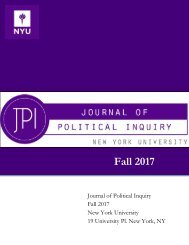Fall2016_Final2
Create successful ePaper yourself
Turn your PDF publications into a flip-book with our unique Google optimized e-Paper software.
and monitor compliance, effectively imposing a legal limit on the regional arms race. The agency could<br />
also impose safeguards on nuclear facilities and materials. The scope of its work and authority would<br />
be determined by the two parties, though it could be strengthened over time. Because the United<br />
States and China are heavily involved in the region, their participation is critical in any attempt to<br />
establish a nuclear arms control regime. China, for example, should consider including negative<br />
security assurance into an agreement establishing a bilateral agency to address India’s fear of a Chinese<br />
nuclear attack. 51 India and Pakistan could also consider making their bilateral nuclear agreement’s entry<br />
into force conditioned upon this criterion being met. Again this highlights the flexibility of a bilateral<br />
arms control system and the importance of tailoring it to suit the specific circumstances of the region.<br />
Following the ABACC’s joint inspection method, inspectors from both India and Pakistan<br />
should jointly conduct routine inspections under the auspices of the bilateral agency. Extending the<br />
scope of verification and safeguards to India’s military nuclear facilities could help to alleviate<br />
international concern, as these military facilities are, at present, out of the scope of the IAEA. 52 India<br />
might be more receptive to this type of inspection than one carried out by international inspectors.<br />
Mutual inspection of India and Pakistan’s nuclear programs would also encourage both countries to<br />
be more responsible actors, as they would have to adopt and adhere to the internationally-recognized<br />
standards.<br />
2) Regional stability is an indispensable part of nuclear rapprochement – Even though<br />
the Argentine-Brazilian nonproliferation measures were caused in large part by changes in domestic<br />
politics, the increase in international stability associated with the end of the Cold War did provide an<br />
atmosphere conducive to nuclear cooperation as well. 53 This point is even more significant in South<br />
Asia, as the presence of unresolved militarized conflicts, notably the Kashmiri dispute, “is the main<br />
cause for failure of attempts to have normal relations between India and Pakistan.” 54 Preventing future<br />
conflict over the disputed province and reaching a permanent political settlement would go a long way<br />
towards improving prospects for nuclear reconciliation and increasing bilateral dialogue on nuclear<br />
conflict resolution. Thus, solving the Kashmiri dispute should not be seen in isolation from an attempt<br />
to tackle South Asian nuclear proliferation.<br />
The international community has a part to play in mitigating the volatile political environment<br />
in the region. U.S. nuclear assistance to India and the Sino-Pakistani nuclear counter-deal only<br />
encouraged the existing nuclear rivalry. This is hardly a recipe for constraining proliferation. U.S. and<br />
Chinese cooperation with India and Pakistan, respectively, give both superpowers diplomatic leverage<br />
over their allies. This influence should be used to force both South Asian countries to normalize their<br />
relations and roll back the present nuclear arms race.<br />
3) The importance of having civilian control over a nuclear weapons establishment –<br />
Eliminating mutual distrust would have been difficult to achieve in Argentina and Brazil without each<br />
country exerting democratic control over the military-controlled nuclear programs. It was the civilian<br />
leaders, not the armed forces, who wanted to elevate their countries to the rank of responsible nuclear<br />
energy-producing countries. This lesson is more applicable in Pakistan than India, because in the<br />
former, the military exercises the sole authority over the use of nuclear weapons. While the Pakistani<br />
military will not likely allow any political reform that would weaken its control over the nuclear forces,<br />
51<br />
A “negative security assurance” is a formal agreement made by a nuclear-weapons state to not launch a nuclear attack against a non-nuclear weapons<br />
state.<br />
52<br />
“Country Profiles – India – Overview,” Nuclear Threat Initiative, accessed May 15, 2016, http://www.nti.org/learn/countries/india/. Under the June<br />
2014 India-IAEA safeguards agreement, the IAEA can only visit and inspect India’s civilian nuclear facilities.<br />
53<br />
John R. Redick, Julio C. Carasales and Paulo S. Wrobel, “Nuclear Rapprochement: Argentina, Brazil, and the Nonproliferation Regime.” Washington<br />
Quarterly 18, no. 1 (1995): 118, doi: 10.1080/01636609509550135.<br />
54<br />
Umbreen Javaid, “Confidence Building Measures in Nuclear South Asia: Limitations and Prospect,” A Research Journal of South Asian Studies 25, no. 2<br />
(July-December 2010): 355, http://pu.edu.pk/images/journal/csas/PDF/10-Dr.%20Umbreen%20Javaid.pdf.<br />
Journal of Political Inquiry | Fall 2016 | 11
















